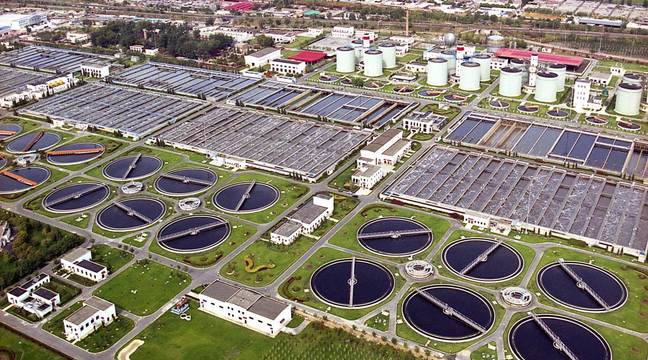
当前课程知识点:Water and Wastewater Treatment Engineering: Biochemical Technology > Chapter 2 Activated sludge process > Section 2.1 Basic concept of activated sludge process > Section 2.1.1 Basic concept of activated sludge process
返回《Water and Wastewater Treatment Engineering: Biochemical Technology》慕课在线视频课程列表
返回《Water and Wastewater Treatment Engineering: Biochemical Technology》慕课在线视频列表
同学们好!欢迎大家来到《水处理工程》MOOC课堂!
今天我们要开始学习第二章,废水好氧生物处理工艺的第一部分,活性污泥法
这一章共有七个小节,内容分别是活性污泥法的基本概念
活性污泥增殖规律及其应用,活性污泥法的运行方式
活性污泥法的反应动力学,以及曝气的原理、方法与设备
活性污泥法的工艺设计,以及最后一节是活性污泥法的运行管理
首先,我们来学习第一章,活性污泥法的基本概念
它的内容包括:活性污泥法的工艺流程及组成
活性污泥的性质及其性能指标;活性污泥法的基本工艺参数
首先,我们来看一个典型的城市污水处理厂的工艺流程
经污水管网收集的城市污水进入格栅间,经污水泵提升后
依次进入曝气沉砂池、初次沉淀池,废水得到初步处理后
再进入曝气池和二次沉淀池,废水中大部分污染物得以去除
水质得以净化,再经消毒后就可以直接排放进入受纳水体
或者再经过一定的深度处理后,可以回用
而在污水处理过程中,初沉池产生的初沉污泥,和二沉池排出的剩余污泥
通常会依次进入污泥浓缩池、污泥厌氧消化池、污泥脱水机
最终以脱水污泥的形式离开污水处理厂,成为固体废弃物
需要进行妥善的进一步处理和处置
由此可以看出,其中的曝气池和二沉池就是我们今天要重点学习的活性污泥工艺
经一级处理后的废水,进入曝气池
在这里,我要特别说明,曝气的"曝"字的标准读音应该是"pu”,即”曝(pu)气”
但是,在水处理行业内,多数人习惯性地还是读成"曝(bao)气"
曝气池中存在着大量的具有很高生物活性的微生物
在不断提供氧气的好氧条件下,这些微生物将废水中的污染物质
氧化分解或者转化为气态或固态的产物,并从水中分离,使废水得到净化
这里,我们可以看一个正在运行的曝气池
如果从其中取出一个量筒的混合液
可以看到混合液中间含有大量黄褐色或者是土黄色的污泥
实际上就是我们所说的活性污泥
其中有大量负责去除废水中污染物的微生物
经过简单沉淀后,污泥会下沉,从而实现泥水分离
其中上清液就是经过处理后的干净的废水
如果将曝气池中的混合液排空
就可以看到我们在曝气池的底部,安装有数量众多的曝气头
一些曝气竖管将压缩空气输送到曝气池的底部
压缩空气通过每个曝气头将空气切割成微小的气泡释放到混合液中
为其中的好氧微生物提供溶解氧
因此,从活性污泥法的工艺流程中,我们可以看到
活性污泥系统主要由以下5个部分组成
即曝气池、二沉池、污泥回流系统、剩余污泥排放系统、供氧或者曝气系统
其中,曝气池是整个系统的核心组成,是生化反应的主体
废水中的污染物,主要在曝气池中间得以去除
活性污泥也会在其中得以增殖
而二沉池,也是活性污泥系统的重要组成部分
它主要有2个功能,即实现泥水分离,保证出水水质
第二,能够对曝气池混合液中间的活性污泥进行浓缩
保证污泥的回流,维持曝气池中间的污泥浓度
污泥回流系统对于维持曝气池中间合适的污泥浓度至关重要
而且呢,可以通过改变污泥回流比
在一定范围内调整曝气池中间的污泥浓度
实现对曝气池运行工况的调整
剩余污泥的排放系统是去除废水中有机物的有效途径之一
活性污泥中的微生物通过合成作用
将废水中的部分有机物转化合成为细胞物质
通过沉淀作用实现泥水分离
最终需要通过剩余污泥的排放才能实现从整个系统中间将有机物排出
同时,及时地从系统中排出剩余污泥,可以维持系统的稳定运行
供氧或曝气系统,对于所有好氧生物处理系统来说,都非常重要
在活性污泥工艺中,曝气可以为微生物提供溶解氧
同时还能促使活性污泥在曝气池中间处在悬浮状态
能够跟废水中间的污染物充分的接触
因此,我们可以看出,维持一个活性污泥系统正常稳定的运行
需要如下的一些基本条件
第一,是废水中含有足够的可溶性易降解有机物
第二,混合液含有足够的溶解氧
第三,活性污泥在池中呈悬浮状态
第四,活性污泥必须连续回流,剩余污泥要及时排放
这样的话,有利于维持曝气池中间稳定的活性污泥浓度
最后一个,进水中间应该不含有对微生物有毒有害的物质
-Section 0.1 Development Status of Wastewater Treatment Process
--Section 0.1 Development Status of Wastewater Treatment Process
-Section 0.2 Typical Processes of Wastewater Biological Treatment
--Section 0.2 Typical Processes of Wastewater Biological Treatment
-Section 1.1 Principles of wastewater aerobic biological treatment
--1.1 Principles of wastewater aerobic biological treatment
-Section 1.2 Principles and determination of wastewater biodegradability
--1.2 Principles and determination of wastewater biodegradability
-Section 1.3 Principles of wastewater anaerobic biological treatment
--Section 1.3.1 Principles of wastewater anaerobic biological treatment(1)
--Section 1.3.2 Principles of wastewater anaerobic biological treatment(2)
-Section 1.4 Principles of wastewater biological nitrogen removal
--Section 1.4 Principles of wastewater biological nitrogen removal
-Section 1.5 Principles of wastewater biological phosphorus removal
--Section 1.5 Principles of wastewater biological phosphorus removal
-Chapter 1 Homework
-Section 2.1 Basic concept of activated sludge process
--Section 2.1.1 Basic concept of activated sludge process
--Section 2.1.2 Basic concept of activated sludge process
-Section 2.2 Growth rule of activated sludge and its application
--Section 2.2 Growth rule of activated sludge and its application
-Section 2.3 Running mode of activated sludge process
--Section 2.3.1 Running mode of activated sludge process(1)
--Section 2.3.2 Running mode of activated sludge process(2)
-Section 2.4 Kinetics of active sludge process
--Section 2.4.1 Kinetics of active sludge process(1)
--Section 2.4.2 Kinetics of active sludge process(2)
--Section 2.4.3 Kinetics of active sludge process(3)
--Research and Development of Kinetic Model of Activated Sludge Process
-Section 2.5 Principle, calculation and equipment of aeration
--Section 2.5.1 Principle, calculation and equipment of aeration(1)
--Section 2.5.2 Principle, calculation and equipment of aeration(2)
-Section 2.6 Designing of activated sludge process
--Section 2.6 Designing of activated sludge process
-Section 2.7 Operation and management of active sludge process
--Section 2.7.1 Operation and management of active sludge process (1)
--Section 2.7.2 Operation and management of active sludge process (2)
-Chapter 2 Homework
-Section 3.1 Basic principle of biofilm
--Section 3.1 Basic principle of biofilm
-Section 3.2 Biofilter process
--Section 3.2.1 Biofilter Process (1)
--Section 3.2.2 Biofilter process (2)
--Section 3.2.3 Biofilter process (3)
-Section 3.3 Biodisk process
-Section 3.4 Biological contact oxidation process
--Section 3.4 Biological contact oxidation process
-Section 3.5 Aerobic biological fluidized bed process
--Section 3.5 Aerobic biological fluidized bed process
-Chapter 3 Homework
-Section 4.1 Oxidation ditch process
--Section 4.1 Oxidation ditch process
-Section 4.2 A-B process
-Section 4.3 SBR process
-Section 4.4 MBR process
-Chapter 4 Homework
-Section 5.1 Overview and characteristics of development of anaerobic biological treatment
--Section 5.1 Overview and characteristics of development of anaerobic biological treatment
-Section 5.2 Anaerobic digester
--Section 5.2 Anaerobic digester
-Section 5.3 Anaerobic contact process and anaerobic filter process
--Section 5.3 Anaerobic contact process and anaerobic filter process
-Section 5.4 UASB process
-Section 5.5 Other anaerobic biological treatment process
--Section 5.5 Other anaerobic biological treatment process
-Section 5.6 Operation management of anaerobic biological treatment process
--Section 5.6 Operation management of anaerobic biological treatment process
-Chapter 5 Homework
-Section 6.1 Introduction
-Section 6.2 Biological nitrogen removal process and technology
--Section 6.2 Biological nitrogen removal process and technology
-Section 6.3 Biological phosphorus removal process and technology
--Section 6.3 Biological phosphorus removal process and technology
-Section 6.4 Simultaneous nitrogen and phosphorus removal process
--Section 6.4 Simultaneous nitrogen and phosphorus removal process
-Chapter 6 Homework
-Section 7 Natural biological treatment process
--Section 7 Natural biological treatment process
-Chapter 7 Homework
-Section 8.1 Source, nature and treatment of sludge
--Section 8.1 Source, nature and treatment of sludge
-Section 8.2 Sludge thickening and digestive stability
--Section 8.2 Sludge thickening and digestive stability
-Section 8.3 Sludge conditioning, dehydration and incineration
--Section 8.3 Sludge conditioning, dehydration and incineration
-Chapter 8 Homework
-Section 9 Wastewater Discharge and Reuse
--Section 9 Wastewater Discharge and Reuse
-Chapter 9 Homework

